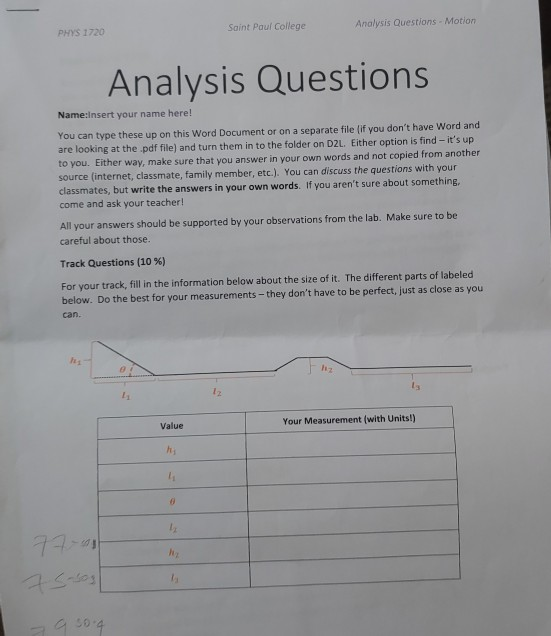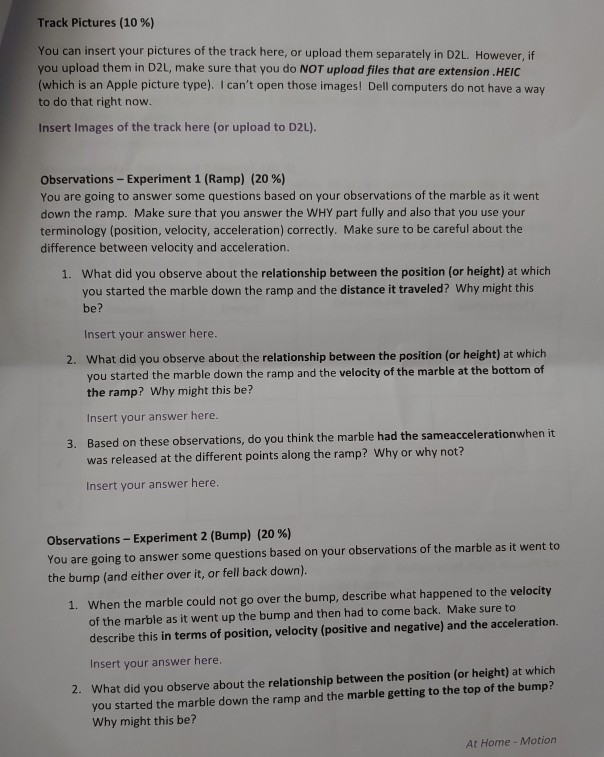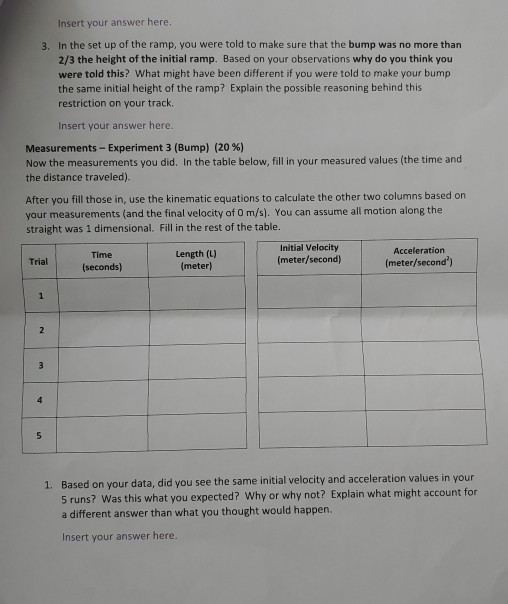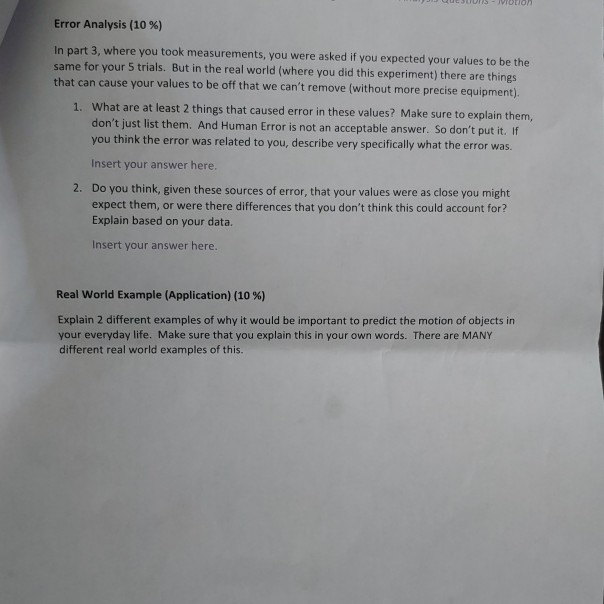Answered step by step
Verified Expert Solution
Question
1 Approved Answer
PHYS 1720 Name:Insert your name here! h You can type these up on this Word Document or on a separate file (if you don't




PHYS 1720 Name:Insert your name here! h You can type these up on this Word Document or on a separate file (if you don't have Word and are looking at the .pdf file) and turn them in to the folder on D2L. Either option is find - it's up to you. Either way, make sure that you answer in your own words and not copied from another source (internet, classmate, family member, etc.). You can discuss the questions with your classmates, but write the answers in your own words. If you aren't sure about something, come and ask your teacher! -0 Analysis Questions All your answers should be supported by your observations from the lab. Make sure to be careful about those. Track Questions (10 %) For your track, fill in the information below about the size of it. The different parts of labeled below. Do the best for your measurements - they don't have to be perfect, just as close as you can. 75403 7900-4 0 4 Value h 4 Saint Paul College 6 4 h 1 Analysis Questions - Motion 12 h Your Measurement (with Units!) Track Pictures (10 %) You can insert your pictures of the track here, or upload them separately in D2L. However, if you upload them in D2L, make sure that you do NOT upload files that are extension.HEIC (which is an Apple picture type). I can't open those images! Dell computers do not have a way to do that right now. Insert Images of the track here (or upload to D2L). Observations - Experiment 1 (Ramp) (20 %) You are going to answer some questions based on your observations of the marble as it went down the ramp. Make sure that you answer the WHY part fully and also that you use your terminology (position, velocity, acceleration) correctly. Make sure to be careful about the difference between velocity and acceleration. 1. What did you observe about the relationship between the position (or height) at which you started the marble down the ramp and the distance it traveled? Why might this be? Insert your answer here. 2. What did you observe about the relationship between the position (or height) at which you started the marble down the ramp and the velocity of the marble at the bottom of the ramp? Why might this be? Insert your answer here. 3. Based on these observations, do you think the marble had the sameaccelerationwhen it was released at the different points along the ramp? Why or why not? Insert your answer here. Observations - Experiment 2 (Bump) (20 %) You are going to answer some questions based on your observations of the marble as it went to the bump (and either over it, or fell back down). 1. When the marble could not go over the bump, describe what happened to the velocity of the marble as it went up the bump and then had to come back. Make sure to describe this in terms of position, velocity (positive and negative) and the acceleration. Insert your answer here. 2. What did you observe about the relationship between the position (or height) at which you started the marble down the ramp and the marble getting to the top of the bump? Why might this be? At Home - Motion Insert your answer here. 3. In the set up of the ramp, you were told to make sure that the bump was no more than 2/3 the height of the initial ramp. Based on your observations why do you think you were told this? What might have been different if you were told to make your bump the same initial height of the ramp? Explain the possible reasoning behind this restriction on your track. Insert your answer here. Measurements - Experiment 3 (Bump) (20 %) Now the measurements you did. In the table below, fill in your measured values (the time and the distance traveled). After you fill those in, use the kinematic equations to calculate the other two columns based on your measurements (and the final velocity of 0 m/s). You can assume all motion along the straight was 1 dimensional. Fill in the rest of the table. Trial 1 2 3 4 5 Time (seconds) Length (L) (meter) Initial Velocity (meter/second) Acceleration. (meter/second) 1. Based on your data, did you see the same initial velocity and acceleration values in your 5 runs? Was this what you expected? Why or why not? Explain what might account for a different answer than what you thought would happen. Insert your answer here.. Error Analysis (10 %) In part 3, where you took measurements, you were asked if you expected your values to be the same for your 5 trials. But in the real world (where you did this experiment) there are things that can cause your values to be off that we can't remove (without more precise equipment). 1. What are at least 2 things that caused error in these values? Make sure to explain them, don't just list them. And Human Error is not an acceptable answer. So don't put it. If you think the error was related to you, describe very specifically what the error was. Insert your answer here. 2. Do you think, given these sources of error, that your values were as close you might expect them, or were there differences that you don't think this could account for? Explain based on your data. Insert your answer here. Real World Example (Application) (10 %) Explain 2 different examples of why it would be important to predict the motion of objects in your everyday life. Make sure that you explain this in your own words. There are MANY different real world examples of this.
Step by Step Solution
★★★★★
3.44 Rating (144 Votes )
There are 3 Steps involved in it
Step: 1
1 Two sources of error that could affect the values in the experiment are a Instrumental error The precision and accuracy of the measuring equipment u...
Get Instant Access to Expert-Tailored Solutions
See step-by-step solutions with expert insights and AI powered tools for academic success
Step: 2

Step: 3

Ace Your Homework with AI
Get the answers you need in no time with our AI-driven, step-by-step assistance
Get Started


